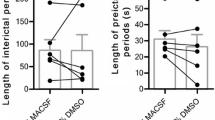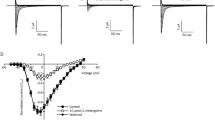Abstract
Actions of the new antiepileptic drug lamotrigine (LTG, Lamictal) were characterised using recombinant rat brain type IIA Na+ channels expressed in Chinese hamster ovary (CHO) cells and native Na+ channels in rat hippocampal pyramidal neurones, using whole-cell recording and intracellular recording techniques. In CHO cells, LTG caused a tonic inhibition of Na+ currents in a concentration-dependent and voltage-dependent manner. The half-maximal inhibitory concentration (IC50) of approximately 500 μM was obtained at a holding potential (V h) of −90 mV compared with an IC50 of 100 μM at a V h of −60 mV. LTG (50 μM) caused a 10−mV negative shift in the slow, steady-state inactivation curve and delayed considerably the recovery from inactivation, but had no significant effects on the voltage dependence of activation or fast inactivation, suggesting that LTG acts mainly on the slow inactivated state. The affinity for the inactivated channels was estimated at 12 μM. The tonic inhibition was augmented by a use-dependent action in which a further inhibition by the drug developed during rapid repetitive stimulation using a train of 20-ms duration pulses (11 Hz). These results were consistent with the drug action being on firing properties of pyramidal neurones. Only in those epileptiform bursts which caused cumulative inactivation of Na+ spikes did LTG produce a potent inhibition. Our data suggest that the inactivated channel is a primary target for LTG action at therapeutic concentrations.
Similar content being viewed by others
References
Bean BP, Cohen CJ, Tsien RW (1983) Lidocaine block of cardiac sodium channels. J Gen Physiol 81:613–642
Benoit E, Escande D (1991) Riluzole specifically blocks inactivated Na channels in myelinated nerve fibre. Pflügers Arch 419:603–609
Brodie MJ (1994) Lamotrigine versus other antiepileptic drugs: a star rating system is born. Epilepsia 35 [Suppl 5]: S41-S46
Catterall WA (1992) Cellular and molecular biology of voltage-gated sodium channels. Physiol Rev 72:S15-S48
Cheung H, Kamp D, Harris E (1992) An in vitro investigation of the action of lamotrigine on neuronal voltage-activated sodium channels. Epilepsy Res 13:107–112
Courtney KR (1975) Mechanism of frequency-dependent inhibition of sodium currents in frog myelinated nerve by the lidocaine derivative GEA 968. Pharmacol Exp Ther 195:225–236
Courtney KR, Etter EF (1983) Modulated anticonvulsant block of sodium channels in nerve and muscle. Eur J Pharmacol 88:1–9
Eaholtz G, Scheuer T, Catterall WA (1994) Restoration of inactivation and block of open sodium channels by an inactivation gate peptide. Neuron 12:1041–1048
Goa KL, Ross SR, Chrisp P (1993) Lamotrigine a review of its pharmacological properties and clinical efficacy in epilepsy. Drugs 46:152–176
Hamill OP, Marty A, Neher E, Sakmann B, Sigworth FJ (1981) Improved patch-clamp techniques for high-resolution current recording from cells and cell-free membrane patches. Pflügers Arch 391:85–100
Hebert T, Drapeau P, Pradier L, Dunn RJ (1994) Block of the rat brain IIA sodium channel α-subunit by the neuroprotective drug riluzole. Mol Pharmacol 45:1055–1060
Hille B (1977) Local anesthetics: hydrophilic and hydrophobic pathways for the drug-receptor reaction. J Gen Physiol 69:497–515
Lang DG, Wang CM, Cooper BR (1993) Lamotrigine, phenytoin and carbamazepine interactions on the sodium current present in N4TG1 mouse neuroblastoma cells. J Pharmacol Exp Ther 266:829–835
Leach MJ, Marden CM, Miller AA (1986) Pharmacological studies of Lamotrigine, a novel potential antiepileptic drug: II. neurochemical studies on the mechanism of action. Epilepsia 27:490–497
Leach MJ, Baxter MG, Critchley MAE (1991) Neurochemical and behavioural aspects of lamotrigine. Epilepsia 32:S4-S8
Lees G, Leach MJ (1993) Studies on the mechanism of action of the novel anticonvulsant lamotrigine (Lamictal) using primary neuroglial cultures from rat cortex. Brain Res 612:190–199
Macdonald RL, Kelly KM (1994) Mechanisms of action of currently prescribed and newly developed antiepileptic drugs. Epilepsia 35 [Suppl 4]:S41-S50
Madison DV, Nicoll RA (1984) Control of the repetitive discharge of rat CA1 pyramidal neurones in vitro. J Physiol (Lond) 354:319–331
Matsuki N, Quandt FN, Ten Eick RE, Yeh JZ (1984) Characterization of the block of sodium channels by phenytoin in mouse neuroblastoma cells. J Pharmacol Exp Ther 228:523–530
Quandt FN (1988) Modification of slow inactivation of single sodium channels by phenytoin in neuroblastoma cells. Mol Pharmacol 34:557–565
Quandt FN, Narahashi T (1982) Modification of single Na+ channels by batrachotoxin. Proc Natl Acad Sci USA 79:6732–6736
Ragsdale DS, Scheuer T, Catterall WA (1991) Frequency and voltage-dependent inhibition of type IIA Na+ channels, expressed in mammalian cell line, by local anesthetic, antiarrhythmic, and anticonvulsant drugs. Mol Pharmacol 40:756–765
Riddall DR, Clackers M, Leach MJ (1993) Correlation of inhibition of veratrine evoked [14C]guanidine uptake with inhibition of veratrine evoked release of glutamate by lamotrigine and its analogues. Can J Neurol Sci Abstr Suppl 4-S181
Rogawski MA, Porter RJ (1990) Antiepileptic drugs: pharmacological mechanisms and clinical efficacy with consideration of promising developmental stage compounds. Pharmacol Rev 42:223–286
Ruben PC, Starkus JG, Rayner MD (1992) Steady state availability of sodium channels: interactions between slow inactivation and activation. Biophys J 61:941–955
Scheuer T, Auld VJ, Boyd S, Offord J, Dunn R, Catterall WA (1990) Functional properties of rat brain sodium channels expressed in a somatic cell line. Science 247:854–858
Strichartz GR (1973) The inhibition of sodium currents in myelinated nerve by quaternary derivatives of lidocaine. J Gen Physiol 62:37–57
Taylor CP (1993) The anticonvulsant lamotrigine blocks sodium currents from cloned α-subunits of rat brain Na+ channels in a voltage-dependent manner but gabapentin does not. Soc Neurosci Abstr 19:1631
van-Wieringen A, Binnie CD, Meijer JW, Peck AW, de-Vries J (1989) Comparison of the effects of lamotrigine and phenytoin on the EEG power spectrum and cortical and brain stem-evoked responses of normal human volunteers. Neuro-psychobiology 21:157–169
Xie XM, Peakman T, Garthwaite J, Lancaster B (1994) Inactivated sodium channels and use-dependent action of the anticonvulsant lamotrigine. Soc Neurosci Abstr 20:718
Xie XM, Peakman T, Lancaster B, Garthwaite J (1995) Selective interaction of lamotrigine with slow inactivated rat brain Na channels (abstract). Epilepsia (in press)
Westenbroek RE, Merrick DK, Catterall WA (1989) Differential subcellular localization of RI, and RII Na+ channel subtypes in central neurons. Neuron 3:695–704
Author information
Authors and Affiliations
Rights and permissions
About this article
Cite this article
Xie, X., Lancaster, B., Peakman, T. et al. Interaction of the antiepileptic drug lamotrigine with recombinant rat brain type IIA Na+ channels and with native Na+ channels in rat hippocampal neurones. Pflügers Arch 430, 437–446 (1995). https://doi.org/10.1007/BF00373920
Received:
Revised:
Accepted:
Issue Date:
DOI: https://doi.org/10.1007/BF00373920




